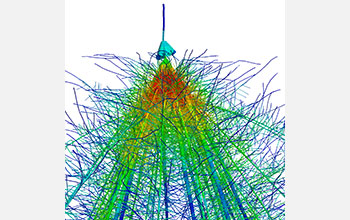Multimedia Gallery
Studying the evolution of maize roots
Pennsylvania State University (Penn State) researchers studying the evolution and specific traits of roots in corn plants used SlimRoot, a computer program they developed, to model the average root architecture of modern maize hybrids (shown) and help compare it to that of older varieties. The modern material had fewer nodal roots, moderately more shallow nodal root angles, and longer lateral roots relative to material from the early 1900s.
To study the evolution of maize root systems, the researchers grew 16 varieties of corn representing maize grown commercially in the U.S. from the early 1900s to the present. The corn was grown in both high- and low-nitrogen plots in three different population-density scenarios representing both historical and modern growing environments. Field experiments were conducted at Penn State's Russell E. Larson Agricultural Research Center.
The researchers found that the newest commercial varieties performed better in every agronomic environment. These varieties also had root characteristics known from previous Penn State research to make plants more efficient at acquiring nitrogen from the soil, including fewer nodal roots, longer lateral roots and larger cortical cells.
The Penn State researchers say selective breeding of maize over the last century to create hybrids with desirable shoot characteristics and increased yield may have contributed indirectly to the evolution of root systems that are more efficient in acquiring nutrients, such as nitrogen, from the soil.
"If we understand how roots have evolved and which specific root traits increase the plant's efficiency, then we can take the next step in breeding that can help decrease pollution, save farmers money and make more yield," says Larry York, a postdoctoral research fellow at the University of Nottingham, U.K., who conducted the study while earning his doctorate in ecology at Penn State.
Results of this study suggest that future breeding efforts that directly select for positive root traits could lead to yield gains needed to help feed a growing world population, while reducing pollution from excess nitrogen and reducing farmers' fertilizer costs.
This research was supported in party by a grant from the National Science Foundation's Basic Research to Enhance Agricultural Development program.
To learn more, see the Penn State news story Study finds that maize roots have evolved to be more nitrogen efficient. (Date image taken: 2014; date originally posted to NSF Multimedia Gallery: Oct. 1, 2015)
Credit: Larry M. York, University of Nottingham
Images and other media in the National Science Foundation Multimedia Gallery are available for use in print and electronic material by NSF employees, members of the media, university staff, teachers and the general public. All media in the gallery are intended for personal, educational and nonprofit/non-commercial use only.
Images credited to the National Science Foundation, a federal agency, are in the public domain. The images were created by employees of the United States Government as part of their official duties or prepared by contractors as "works for hire" for NSF. You may freely use NSF-credited images and, at your discretion, credit NSF with a "Courtesy: National Science Foundation" notation.
Additional information about general usage can be found in Conditions.
Also Available:
Download the high-resolution JPG version of the image. (3.2 MB)
Use your mouse to right-click (Mac users may need to Ctrl-click) the link above and choose the option that will save the file or target to your computer.

